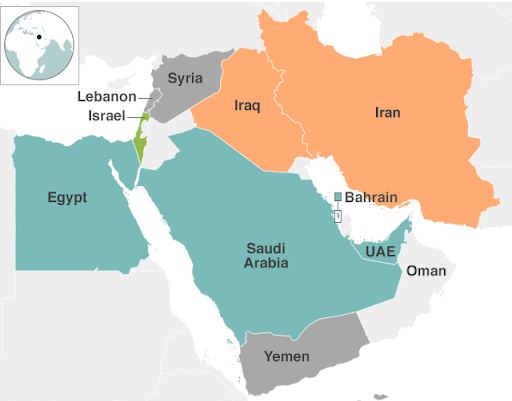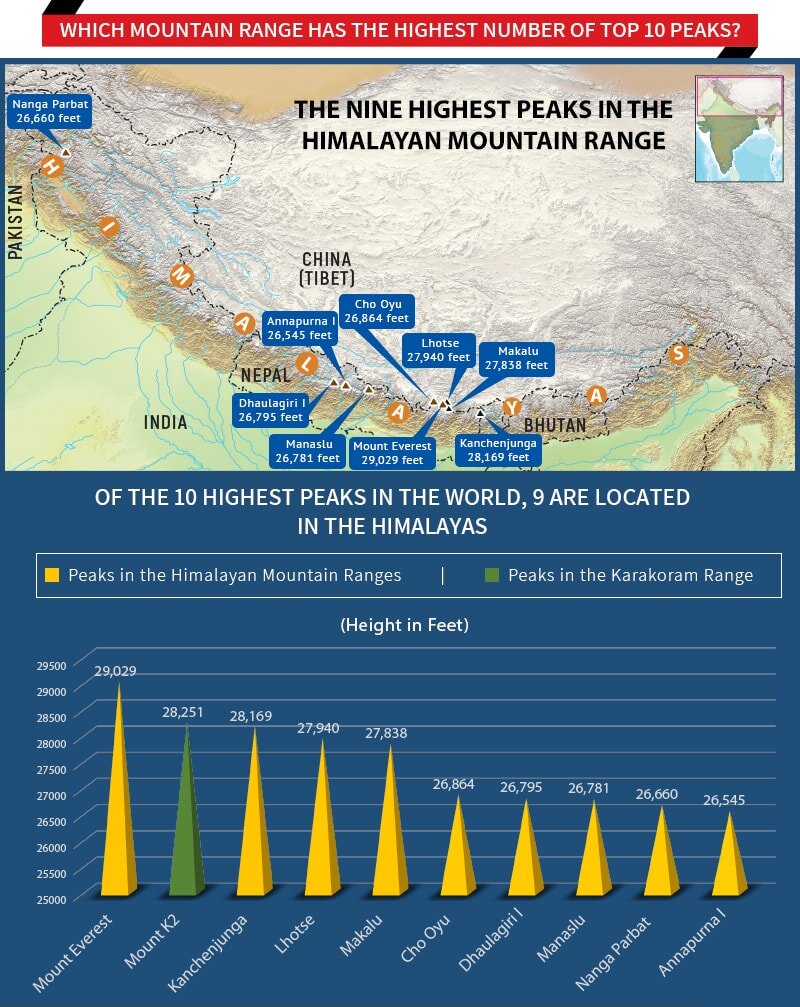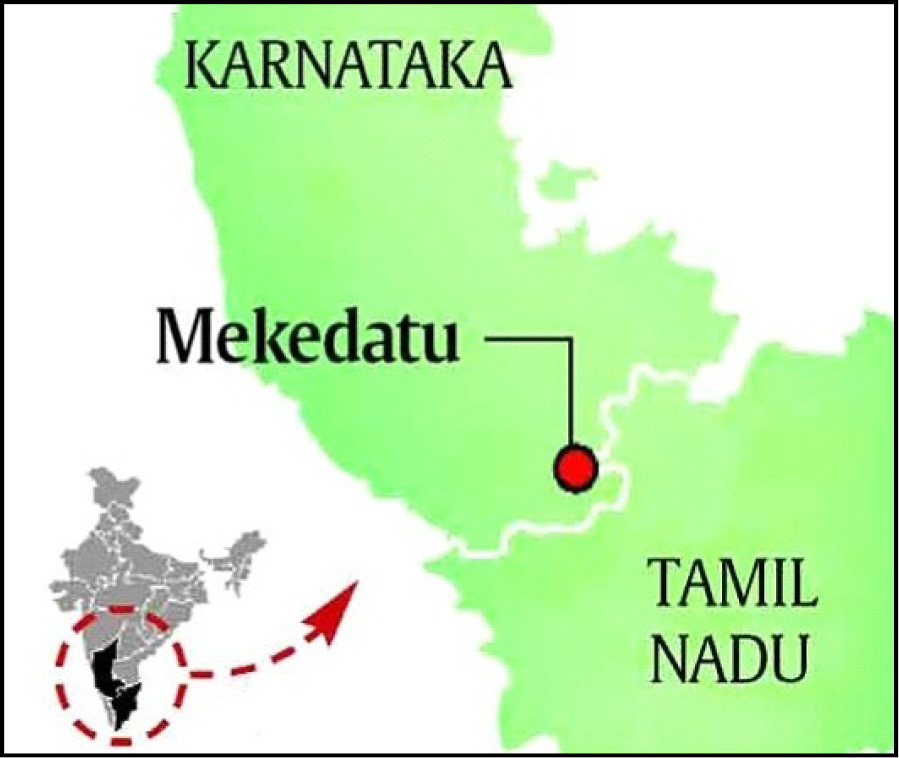International Relations
Israel, UAE and Bahrain Abraham Accord
Why in News
The Abraham Accord between Israel, the United Arab Emirates and Bahrain is mediated by the USA. It is the first Arab-Israeli peace deal in 26 years.
Key Points
- Previous Agreements: There were the only two peace deals between Israel and the Arab States in more than a quarter of a century.
- Egypt was the first Arab State to sign a peace deal with Israel in 1979.
- Jordan signed a peace pact in 1994.
- The Agreement:
- As per the agreements, the UAE and Bahrain will establish:
- Embassies and exchange ambassadors.
- Working together with Israel across a range of sectors, including tourism, trade, healthcare and security.
- The Abraham Accords also open the door for Muslims around the world to visit the historic sites in Israel and to peacefully pray at Al-Aqsa Mosque in Jerusalem, the third holiest site in Islam.
- In the Islamic tradition, the Kaaba in Mecca is considered the holiest site, followed by the Prophet's Mosque in Medina, and Al-Aqsa Mosque in Jerusalem.
- As per the agreements, the UAE and Bahrain will establish:
- Reason: Bringing Israel, the UAE and Bahrain together reflects their shared concern about Iran’s rising influence in the region and development of ballistic missiles. Iran has been critical of both deals.
Arab-Israel Relation
- Since Israeli independence in 1948, it has fought several wars with Arab neighbouring countries.
- The persecuted Jews saw Israel as their promised home while Arabs saw it as an occupation.
- Significance of the Accord:
- The agreement shows how the Arab countries are gradually decoupling themselves from the Palestine question.
- Palestine was among former Ottoman territories placed under UK administration by the League of Nations in 1922. All of these territories eventually became fully independent States, except Palestine.
- Full diplomatic ties will be established between Israel, the United Arab Emirates and Bahrain which will have a positive impact on the entire region.
- The deal buys UAE a lot of goodwill in the US, where its image has been tarnished by its involvement in the Yemen war.
- In South Asia, it will put Pakistan in a bind, whether to follow UAE’s steps (will be seen as giving up Islamic cause of Palestine) or not to follow the UAE (since it is already in feud with the Saudis over not taking up the Kashmir case, Pakistan cannot afford another hostile Islamic Country).
- In the upcoming presidential election in the USA, the accord could help shore up support among pro-Israel Christian evangelical voters, an important part of current President’s political base.
- The agreement shows how the Arab countries are gradually decoupling themselves from the Palestine question.
- More Deals:
- Other gulf states in the region like Oman could follow suit and sign similar agreements with Israel
- One of the biggest Gulf Arab powers, Saudi Arabia could follow the suit as well.
- Concern:
- The Palestinians have not embraced the USA’s vision. 86% of Palestinians believe the normalization agreement with the UAE serves only Israel’s interests and not their own.
- There is a possibility that the Palestine quest is further ignored.
- Shia-Sunni rifts in the region may get wide and violent.
- Saudi Arabia (Sunni) and Iran (representing Shia) have a long history of enmity. For decades, one of the main sources of instability in West Asia has been the cold war between Saudi Arabia and Iran.
- The Sunni-Shiite schism may also provoke violence between Muslims in such places as Pakistan, Nigeria and Indonesia.
- The Palestinians have not embraced the USA’s vision. 86% of Palestinians believe the normalization agreement with the UAE serves only Israel’s interests and not their own.
- Indian Interest in West Asia:
- Geopolitical: West Asia occupies an important position in international relations due to its geographical location and proximity to continents and countries South Asia, China, Central Asia, Europe, and Africa.
- Energy: The region is strategically significant due to its enormous energy resources, trade route links to different parts of the world.
- It is the world's largest oil-producing region accounting for 34% of world production, 45% of crude oil exports and 48% of oil proven reserves.
- Diaspora: Indian expatriates have constituted a substantial share of the regional labour market.
- Remittances from the region constitute a major chunk of total remittances to India.
- Opportunity for India:
- Defence and Security: India should use this unexpected opportunity to give itself a bigger role in a region which is its strategic backyard. The first step should be to ramp up defence and security relations with UAE.
- Israel is already a very close defence partner.
- While some work has already happened, India should leverage its economy for a bigger opening in this region. Importantly, India can use its good offices to ensure that any future deal on a regional security framework gives adequate space to Iran, which may be weak but not so weak that it cannot be a hugely disruptive power if it so chooses.
- Defence and Security: India should use this unexpected opportunity to give itself a bigger role in a region which is its strategic backyard. The first step should be to ramp up defence and security relations with UAE.
Way Forward
- A balance between Shia and Sunni, between Persian and Arab, is key to any sustainable peace.
- The US may be a pre-eminent power in the Middle East, but Russia has made a space for itself, spending a lot less money. In recent years, China has indicated its willingness to play a larger role in this region, and is close to both UAE and Israel and, increasingly, Saudi Arabia.
- India should make its moves before this market and this extended neighbourhood come under the Chinese sphere of influence.
- A deal that could, if played right, open the doors for a changed geopolitical arrangement in the Middle East should have a stronger Indian footprint.
Biodiversity & Environment
Phytoplankton Biomass in Bay of Bengal
A team of scientists from the Indian National Centre for Ocean Information Services (INCOIS) have discovered a way to measure the quantity of chlorophyll-a that indicates abundance of phytoplanktons in the Bay of Bengal in real-time.
Key Points
- Phytoplanktons: They are tiny microscopic floating plants found in water bodies.
- Study of phytoplankton biomass is done by analyzing chlorophyll-a, a dominant pigment found in phytoplankton cells.
- Significance of Phytoplanktons:
- They contribute more than half of the oxygen in the environment.
- They reduce global warming by absorbing human-induced carbon dioxide.
- They also serve as the base of the ocean food chain.
- They are important bioindicators regulating life in oceans. Their abundance determines the overall health of the ocean ecosystem.
- Study: The scientists closely tracked the long-term trends of chlorophyll-a in the northwestern Bay of Bengal.
- It was based on in-situ and satellite data spanning over the last 16 years, from January 2003 to December 2018.
- National Aeronautics and Space Administration (NASA)’s MODIS (Moderate Resolution Imaging Spectroradiometer), NASA’s VIIRS (Visible Infrared Imaging Radiometer Suite) sensor and Indian Space Research Organisation (ISRO)’s OCM-2 (Ocean Colour Monitor-2) were used for satellite data.
- Findings: There were two peaks of chlorophyll-a — the primary peak occurred during the pre-southwest monsoon due to the recurrent phytoplankton bloom in the coastal water and the secondary peak occurred during the end of the southwest monsoon, spreading to far offshore areas.
- Reasons: Along with increase in phytoplanktons, other reasons for peak in chlorophyll-a may be physical forces such as upwelling, wind-induced vertical mixing, convective overturn and chemicals from various sources including river runoff.
- Conclusions:
- Increased Nutrients and More Phytoplanktons: It reveals that the study area experienced maximum spatial variability during pre-southwest monsoon with salinity, and nutrients, the major controlling factors for the abundance and distribution of phytoplankton.
- Chances of Eutrophication: Increase in nutrients could tell an overall improved health status of the ecosystems as a whole; at the same time excessive phytoplanktons could be detrimental to ocean health because of eutrophication.
- Eutrophication: When a water body becomes overly enriched with minerals and nutrients which induce excessive growth of algae or algal bloom.
- This process also results in oxygen depletion of the water body affecting other aquatic animals.
- Chlorophyll is the major pigment used by plants for photosynthesis, the process by which light energy is converted to chemical energy through the synthesis of organic compounds.
- The word chlorophyll comes from two Greek words; Chloros which means green and phyllon which means leaf.
- There are four types of chlorophyll:
- Chlorophyll a, found in all higher plants, algae and cyanobacteria.
- Chlorophyll b, found in higher plants and green algae.
- Chlorophyll c, found in diatoms, dinoflagellates and brown algae; and
- Chlorophyll d, found only in red algae.
Way Forward
- This kind of information on marine environmental parameters is now becoming increasingly important as they serve as a basis for monitoring climate change, river discharge, and the impact of pollution in the ocean.
- The phytoplankton is largely dependent on light, temperature and nutrients. It is therefore, continuous monitoring of the ocean ecosystem is the need of the hour to devise mitigation systems to encounter disruption caused by algal bloom because of excessive phytoplankton enrichment in the coastal water.
Indian Economy
Parliamentary Committee Report on Startups
Why in News
Recently, the Parliamentary Standing Committee on Finance tabled a report related to startups in Parliament. The Government of India has initiated a Startup India Scheme in 2016.
Key Points
- Recommendations:
- Indian start-ups need to reduce their dependence on China and the USA, so that India becomes self-reliant by having several large domestic growth funds powered by domestic capital.
- E.g Small Industries Development Bank of India (SIDBI) Fund-of-Funds vehicle should be expanded and fully operationalised to play an investment role.
- A fund-of-funds also known as a multi-manager investment—is a pooled investment fund that invests in other types of funds.
- Foreign development finance institutions may also be encouraged to participate with local asset management companies to set up fund-of-funds structures.
- E.g Small Industries Development Bank of India (SIDBI) Fund-of-Funds vehicle should be expanded and fully operationalised to play an investment role.
- The companies and Limited Liability Partnerships (LLPs) should be allowed to invest in start-ups without being classified as Non-banking Financial Companies (NBFCs) by the Reserve Bank of India (RBI) to expand capital sources for start-ups.
- Abolition of Long Term Capital Gains (LTCG) tax on Collective Investment Vehicles (CIVs) for at least the next two years to encourage investment in start-ups and to drive a sharp post-pandemic revival.
- At present, LTCG earned by foreign investors in private companies attracts taxation at a rate of 10%, in comparison to the domestic venture capital investments which are taxed at 20% (for LTCG) with an enhanced surcharge of 37%.
- After a two-year period, the Securities Transaction Tax (STT) may be applied to CIVs so that revenue neutrality is maintained.
- A CIV is any entity that allows investors to pool their money and invest the pooled funds, rather than buying securities directly as individuals. It is usually managed by a fund management company which is paid a fee for doing so.
- Examples of CIV: angel funds, alternate investment funds and investment LLP.
- Indian start-ups need to reduce their dependence on China and the USA, so that India becomes self-reliant by having several large domestic growth funds powered by domestic capital.
- Benefits: A strong start-up ecosystem can propel investment, jobs, and demand creation in the economy.
Startup India Scheme
- It is a flagship initiative of the Government of India, intended to catalyse startup culture and build a strong and inclusive ecosystem for innovation and entrepreneurship in India.
- Since the launch of the initiative in 2016, Startup India has rolled out several programs with the objective of supporting entrepreneurs, and transforming India into a country of job creators instead of job seekers.
- A startup is an enterprise that is initiated by its founders around an idea or a problem with a potential for significant business opportunity and impact.
Securities Transaction Tax
- It is a tax levied at the time of purchase and sale of securities listed on stock exchanges in India.
- Both purchaser and seller both need to pay 0.1% of share value as STT.
Capital Gain Tax
- Any profit or gain that arises from the sale of a ‘capital asset’ is a capital gain. This gain or profit comes under the category of ‘income’.
- Land, building, house property, vehicles, patents, trademarks, leasehold rights, machinery, and jewellery are a few examples of capital assets.
- Hence, the capital gain tax will be required to be paid for that amount in the year in which the transfer of the capital asset takes place. This is called the capital gains tax, which can be both short-term or long-term.
- Long-term Capital Gains Tax: It is a levy on the profits from the sale of assets held for more than a year.
- Short-term Capital Gains Tax: It applies to assets held for a year or less and is taxed as ordinary income.
Small Industries Development Bank of India
- Small Industries Development Bank of India (SIDBI) was set up in 1990. It is a statutory body established under an Act of Parliament.
- It acts as the principal financial institution for promotion, financing and development of the Micro, Small and Medium Enterprise (MSME) sector as well as for coordination of functions of institutions engaged in similar activities.
Biodiversity & Environment
Living Planet Report: WWF
Why in News
According to the Living Planet Report 2020 released by the World Wide Fund for Nature, the population of vertebrate species has largely declined in the past half- century.
- Vertebrates : Vertebrates are animals that have backbones or vertebral columns. They are also characterized by a muscular system consisting primarily of bilaterally paired masses and a central nervous system partly enclosed within the backbone.
World Wildlife Fund for Nature
- It is the world’s leading conservation organization and works in more than 100 countries.
- It was established in 1961 and is headquartered at Gland, Switzerland.
- Its mission is to conserve nature and reduce the most pressing threats to the diversity of life on Earth.
- WWF collaborates at every level with people around the world to develop and deliver innovative solutions that protect communities, wildlife, and the places in which they live.
Key Points
- Methodology: The Report used the Living Planet Index to calculate the decline in vertebrate species.
- Living Planet Index (LPI): It is a measure of the state of the world’s biological diversity based on population trends of vertebrate species in terrestrial, freshwater and marine habitats.
- It is released by Institute of Zoology (Zoological Society of London)
- Founded in 1826, Zoological Society of London is an international conservation charity working for wildlife conservation.
- LPI tracked almost 21,000 populations of more than 4,000 vertebrate species between 1970 and 2016.
- Findings:
- It shows an average 68% decline in global vertebrate species populations, between 1970 and 2016. In the Asia Pacific the decline stands at 45%.
- A 94% decline in the LPI for the tropical subregions of the americas is the largest fall observed in any part of the world.
- Freshwater species populations have reduced by 84% on average since 1970.
- Freshwater species populations are being lost faster than terrestrial or marine species. According to the International Union for Conservation of Nature (IUCN), almost 1/3rd of freshwater species are now threatened with extinction.
- Wildlife populations in freshwater habitats suffered a decline of 84%, equivalent to 4% per year, particularly in Latin America and the Caribbean.
- Megafauna, or bigger species in terms of size, are more vulnerable because they were subjected to intense anthropogenic threats and overexploitation.
- For eg. Large fishes are also heavily impacted by dam construction that blocks their migratory routes to spawning and feeding grounds.
- Since 1970, our Ecological Footprint has exceeded the Earth’s rate of regeneration.
- Ecological Footprint measures the ecological assets that a given population requires to produce the natural resources it consumes (including plant-based food and fiber products, livestock and fish products, timber and other forest products, space for urban infrastructure) and to absorb its waste, especially carbon emissions.
- The human enterprise currently demands 1.56 times more than the amount that Earth can regenerate. It is like living off 1.56 Earths.
- It shows an average 68% decline in global vertebrate species populations, between 1970 and 2016. In the Asia Pacific the decline stands at 45%.
- Threats to Biodiversity:
- Changes in Land and Sea Use, including Habitat Loss and Degradation: This refers to the modification of the environment where a species lives, by complete removal, fragmentation or reduction in quality of key habitat.
- Species Overexploitation: Direct overexploitation refers to unsustainable hunting and poaching or harvesting. Indirect overexploitation occurs when non-target species are killed unintentionally.
- Pollution: Pollution can directly affect a species by making the environment unsuitable for its survival. It can also affect a species indirectly, by affecting food availability or reproductive performance.
- Invasive Species and Disease: Invasive species can compete with native species for space, food and other resources, can turn out to be a predator for native species, or spread diseases that were not previously present in the environment. Humans also transport new diseases from one area of the globe to another.
- Climate Change: As temperatures change, some species will need to adapt by shifting their range to track a suitable climate. The effects of climate change on species are often indirect. For eg, change in migratory patterns of birds.
Way Forward
- Research shows the world could start to stabilize and reverse the loss of nature by embracing bolder, more ambitious conservation efforts as well as making transformational changes in the way food is produced and consumed, such as making food production and trade more efficient, reducing waste, and favouring healthier and more sustainable diets.
- The report also underscores the need for a global New Deal for Nature and People with clear, ambitious goals, to see us on the path to recovery by 2030.
- Diseases like Covid-19 are one of the many connections between the health of people and the planet. How humanity chooses to recover from the pandemic, and address the looming threats from global environmental change, will influence the health and livelihoods of generations to come.
Science & Technology
Phosphine on Venus: A Sign of Life
Why in News
Scientists have detected the presence of phosphine in the atmosphere of Venus.
- The detection indicates the possibility of the presence of lifeforms on Venus.
Key Points
- The international scientific team first spotted the phosphine using the James Clerk Maxwell Telescope (JCMT) in Hawaii and confirmed it using the Atacama Large Millimeter/submillimeter Array (ALMA) radio telescope in Chile.
- JCMT is the largest astronomical telescope in the world designed specifically to operate in the submillimetre wavelength region of the spectrum.
- ALMA is currently the largest radio telescope in the world.
- The researchers did not discover actual life forms, but noted that, on Earth, phosphine is produced by bacteria thriving in oxygen-starved environments.
- Biosignatures: Scientists have used probes and telescopes to seek “biosignatures” - indirect signs of life - on other planets and moons in the solar system and beyond.
- Phosphine was seen at 20 parts-per-billion in the Venus atmosphere which is a trace concentration. However, Venus is considered to be hostile to phosphine as its surface and atmosphere are rich in oxygen compounds that would rapidly react with and destroy phosphine.
- Phosphine acts as a biosignature because it is known to be produced mainly through biological processes, and not through any naturally occurring chemical process.
-
Earlier in 2011, the European Space Agency’s mission, Venus Express, found signs of ozone, a biomarker, in the upper atmosphere of Venus.
- Acid Test:
- Scientists have suspected that the Venusian high clouds, with mild temperatures around 86 degrees Fahrenheit, could harbour aerial microbes that could endure extreme acidity.
- These clouds are around 90% sulphuric acid and Earth microbes could not survive that acidity.
Phosphine
- Phosphine is a phosphorus atom with three hydrogen atoms attached (PH3) – is highly toxic to people.
- On rocky planets such as Venus and Earth, phosphine can only be made by life—whether human or microbe.
- Phosphine is made naturally by some species of anaerobic bacteria—organisms that live in the oxygen-starved environments of landfills, marshlands, and even animal guts.
- To produce phosphine, Earth bacteria take up phosphate from minerals or biological material and add hydrogen.
- Phosphine also arises non-biologically in certain industrial settings.
- Used as a chemical weapon during World War I.
- Phosphine is still manufactured as an agricultural fumigant, is used in the semiconductor industry, and is a by-product of meth labs.
Venus
- Venus is Earth’s closest planetary neighbour. It is also known as earth's twin.
- Similar in structure but slightly smaller than Earth, it is the second planet from the sun.
- Early science observations of Venus revealed that it is a menace of a world that could kill life in multiple ways. Venus is wrapped in a thick and toxic atmosphere that traps in heat.
- High Temperature: Surface temperatures reach a scorching 880 degrees Fahrenheit, hot enough to melt lead. It is the hottest planet in the solar system.
- High Pressure: Highly dense, 65 miles of cloud and haze, puts atmospheric pressure more than 90 times what’s felt on Earth’s surface.
- Also, the planet’s atmosphere is primarily suffocating carbon dioxide and sulfuric acid clouds.
Way Forward
- The finding can further ignite interest in space missions to Venus. Missions to Venus are not new. Spacecraft have been going near the planet since the 1960s, and some of them have even made a landing.
- All future missions to Venus would now be attuned to investigating further evidence of the presence of life. This can now only be taken further by making in situ measurements in the atmosphere of Venus. This poses its own challenges. Apart from the high surface temperature and dense atmosphere, the presence of sulphuric acid in the atmosphere of Venus makes it a highly corrosive environment. The Indian Space Research Organisation (ISRO) is also planning a mission to Venus, tentatively called Shukrayaan, in the near future.
Geography
Re-measuring Mount Everest
Why in News
China and Nepal are soon expected to announce Mount Everest’s latest official height.
- In 2019, both countries agreed to re-measure the elevation of the world’s highest mountain and announce the findings together.
Key Points
- About:
- Mount Everest (also called Sagarmatha in Nepal) is Earth’s highest mountain above sea level, located in the Himalayas between China and Nepal with their borders running across its summit point.
- Its current official elevation is 8,848m which places it more than 200m above the world’s second-highest mountain, K2, which is 8,611m tall and located in Pakistan-occupied Kashmir.
- Mount Everest gets its English name from Sir George Everest, a colonial-era geographer who served as the Surveyor General of India in the mid-19th century.
- It was first scaled in 1953 by the Indian-Nepalese Tenzing Norgay and New Zealander Edmund Hillary.
- First Survey of Everest:
- The first effort was carried out in 1847 by a team led by Andrew Waugh, Surveyor General of India.
- The survey was based on trigonometric calculations and is known as the Great Trigonometric Survey of India.
- The team discovered that ‘Peak 15’ (as Mount Everest was referred to then) was the highest mountain, contrary to the then-prevailing belief that Mount Kanchenjunga (8,582m and the 3rd highest peak in the world now) was the highest peak in the world.
- The first effort was carried out in 1847 by a team led by Andrew Waugh, Surveyor General of India.
- Need for Re-measurement:
- Everest’s current official height has been widely accepted since 1956 when the figure was measured by the Survey of India.
- However, the height of a summit changes due to tectonic activities like the 2015 Nepal earthquake.
- Its measurement over the decades has also depended on who was surveying.
- Previous measurements of the mountain were by Indian, American or European surveyors.
- The joint effort represents national pride for Nepal which will come up with its own findings on the height.
- Everest’s current official height has been widely accepted since 1956 when the figure was measured by the Survey of India.
Survey of India
- It is the National Survey and Mapping Organisation of the country under the Department of Science and Technology.
- It was established in 1767 and is the oldest scientific department of the Government of India.
- Headquarters: Dehradun, Uttarakhand.
- It acts as an adviser to the Government of India on all survey matters, viz Geodesy, Photogrammetry, Mapping and Map Reproduction.
- Geodesy is the science of accurately measuring and understanding the Earth's geometric shape, orientation in space and gravity field.
- Photogrammetry is the science of making measurements from photographs.
Himalayas
- Origin: The northward drift of the Indo-Australian plate resulted in its collision with the much larger Eurasian Plate. Due to which, the sedimentary rocks which were accumulated in the geosyncline known as the Tethys were folded to form the mountain system of western Asia and Himalaya.
- Features:
- The Himalayas are geologically young and structurally folded mountains and represent the loftiest and one of the most rugged mountain barriers of the world.
- They form an arc, which covers a distance of about 2,400 km. Their width varies from 400 km in Kashmir to 150 km in Arunachal Pradesh.
- Orientation:
- The general orientation of these ranges is from northwest to the southeast direction in the northwestern part of India.
- Himalayas in the Darjeeling and Sikkim regions lie in an east west direction.
- In Arunachal Pradesh they are from southwest to the northwest direction.
- In Nagaland, Manipur and Mizoram, they are in the north south direction.
- The Himalayan mountains consist of three parallel ranges in longitudinal extent:
- Great Himalaya or Himadri: It is the northernmost and the most continuous range consisting of the loftiest peaks with an average height of 6,000 m. World’s highest peaks are located in it.
- Lesser Himalaya or Himachal: To the south of Himadri, it is the most rugged mountain system and is known as Himachal or lesser Himalaya. The altitude varies between 3,700 and 4,500 m. It is well known for its hill stations like Kashmir, Kangra and Kullu Valleys.
- Shiwalik: It is the southernmost range with an altitude varying between 900 and 1100 m. These ranges are composed of unconsolidated sediments brought down by rivers from the main Himalayan ranges located farther north.
- There are large-scale regional variations within the Himalayas. On the basis of relief, alignment of ranges and other geomorphological features, the Himalayas can be divided into the following subdivisions:
- Kashmir or Northwestern Himalayas.
- Himachal and Uttaranchal Himalayas.
- Darjeeling and Sikkim Himalayas.
- Arunachal Himalayas.
- Eastern Hills and Mountains.
Science & Technology
Stamp on India’s First Anti Satellite Missile (A-SAT)
Why in News
A Customized My Stamp on India’s First Anti Satellite Missile (A-SAT) launch was released by the Department of Posts on the occasion of Engineers Day.
Engineers Day
- 15th September is observed as Engineer’s Day in India to mark the birth anniversary of Sir Mokshagundam Visvesvaraya (1861-1962), a civil engineer and statesman.
- He was a pioneer in his field, credited for inventing the Block System for dams – the automated doors shut during an overflow.
- He was appointed Chief Engineer of Mysore State in 1909, given the status of Diwan of Mysore in 1912, awarded the Bharat Ratna in 1955.
- His books, “Reconstructing India” and “Planned Economy of India” were published in 1920 and 1934, respectively.
Key Points
- My Stamp: It is the brand name for personalized sheets of Postage Stamps of India Post.
- ‘My Stamp’ was first introduced in India during the World Philatelic Exhibition, ‘INDIPEX-2011’.
- Customized My Stamp is a personalized sheet of Postage Stamps wherein the corporate, organizations and institutions can get their customized sheets printed from India Post.
- A-SAT Missile
- It is an interceptor missile that destroys or jams satellites in space.
- Two types of A-SATs: Kinetic and Non-Kinetic A-SATs.
- Kinetic A-SATs, like ballistic missiles physically strike an object in order to destroy it.
- Non-Kinetic A-SATs: A variety of nonphysical means can be used to disable or destroy a space object. These include frequency jamming, blinding lasers or cyberattacks.
Mission Shakti
- Defence Research and Development Organisation (DRDO) successfully conducted India’s first Anti-Satellite (A-SAT) missile test ‘Mission Shakti’.
- It was launched from Dr APJ Abdul Kalam Island in Odisha on 27th March 2019.
- The interceptor missile was a three-stage missile with two solid rocket boosters.
Significance:
- The entire effort was indigenous which demonstrated the Nation’s capability to develop such complex and critical missions.
- With this success, India became the fourth nation in the world to possess such capability.
- With the establishment of India as a space power, India will be accorded a place in any future international treaty that relates to the governance or usage of Space.
- In case of Pakistan, a terrestrial power, the use of nuclear arsenal can now come at a heavy cost.
- As of now Pakistan presumes that the no first use doctrine of India gives it an advantage, but with the development of ASAT capabilities, India would be able to destroy an incoming Pakistani nuclear missile.
- This will create a significant deterrence vis-a-vis the position of Pakistan.
- In case of China, which is a significant space power, counter-space capabilities of India will provide a critical balancing deterrent.
Governance
Mekedatu Project
Why in News
The Karnataka government is likely to pressurise the Centre for approval of the construction of the Mekedatu Project on the Cauvery river.
- Mekedatu, meaning goat’s leap, is a deep gorge situated at the confluence of the rivers Cauvery and its tributary Arkavathi.
- Ontigondlu is the proposed reservoir site, situated at Ramanagara district in Karnataka about 100 km away from Bengaluru. It is the midst of the Cauvery Wildlife Sanctuary.
- The Rs. 9,000 crore project aims to store and supply water for drinking purposes for the Bengaluru city. Around 400 megawatts (MW) of power is also proposed to be generated through the project.
Key Points
- The project was first approved by the Karnataka state government in 2017.
- It received approval from the erstwhile Ministry of Water Resources for the detailed project report and is awaiting approval from the Ministry of Environment, Forest and Climate Change (MoEFCC).
- The approval from MoEFCC is crucial because 63% of the forest area of the Cauvery Wildlife Sanctuary will be submerged.
- 5,051 hectares of forests would be submerged, including 3,181 hectares in the sanctuary and 1,870 hectares in the reserve forest.
- 4.75 thousand million cubic feet of water could be drawn from the reservoir to partially meet the drinking needs of Bengaluru.
- Tamil Nadu has approached the Supreme Court (SC) against the project even if Karnataka has held that it would not affect the flow of water to Tamil Nadu.
- In June 2020, during the Cauvery Water Management Authority’s meeting, Tamil Nadu reiterated its opposition to the project.
- Reasons for Opposition by Tamil Nadu:
- Tamil Nadu is opposed to any project being proposed in the upper riparian unless it was approved by the Supreme Court.
- Karnataka has no right to construct any reservoir on an inter-state river without the consent of the lower riparian state i.e. Tamil Nadu in this case.
- The project is against the final order of the Cauvery Water Disputes Tribunal (CWDT) in which the SC held that no state can claim exclusive ownership or assert rights to deprive other states of the waters of inter-state rivers.
- The CWDT and the SC have found that the existing storage facilities available in the Cauvery basin were adequate for storing and distributing water so Karnataka’s proposal is ex-facie (on the face of it) untenable and should be rejected outright.
- It has also held that the reservoir is not just for drinking water alone, but to increase the extent of irrigation, which is in clear violation of the Cauvery Water Disputes Award.
Important Facts For Prelims
Adjournment Motion
Why in News
Recently, an adjournment motion notice was moved in the Lok Sabha over the surveillance of key Indian personalities by a firm linked to the Chinese government.
Key Points
- Adjournment motion is introduced only in the Lok Sabha to draw the attention of the House to a definite matter of urgent public importance.
- It involves an element of censure against the government, therefore Rajya Sabha is not permitted to make use of this device
- It is regarded as an extraordinary device as it interrupts the normal business of the House. It needs the support of 50 members to be admitted.
- The discussion on this motion should last for not less than two hours and thirty minutes.
- However, right to move a motion for an adjournment of the business of the House is subject to the following restrictions. i.e. It should:
- Raise a matter which is definite, factual, urgent and of public importance.
- Not cover more than one matter.
- Be restricted to a specific matter of recent occurrence.
- Not raise a question of privilege.
- Not revive discussion on a matter that has been discussed in the same session.
- Not deal with any matter that is under adjudication of court.
- Not raise any question that can be raised on a distinct motion.











